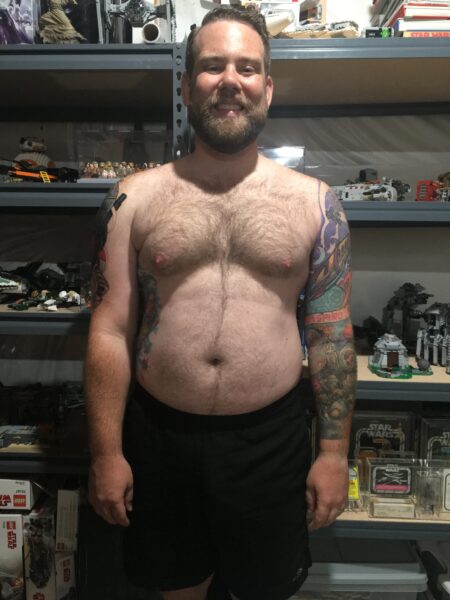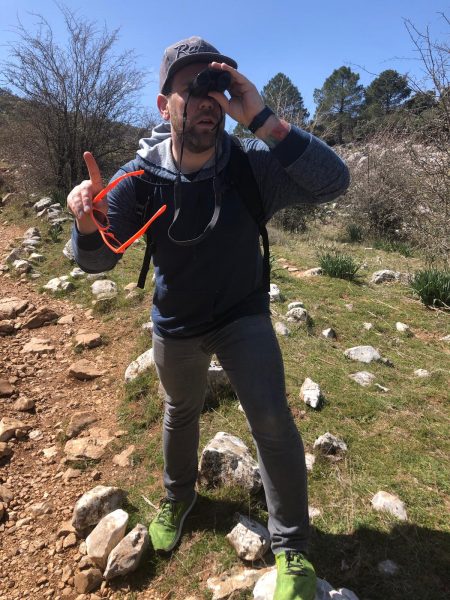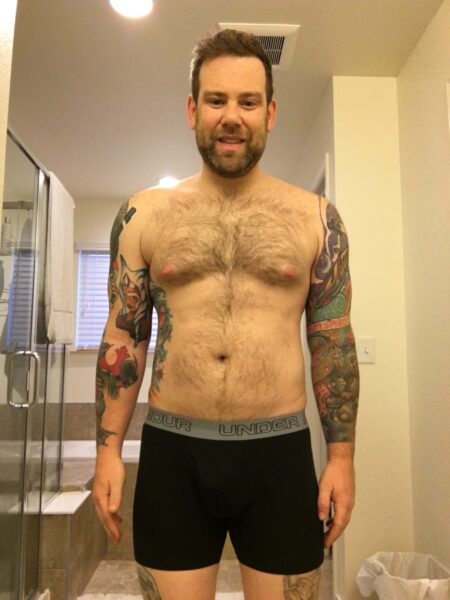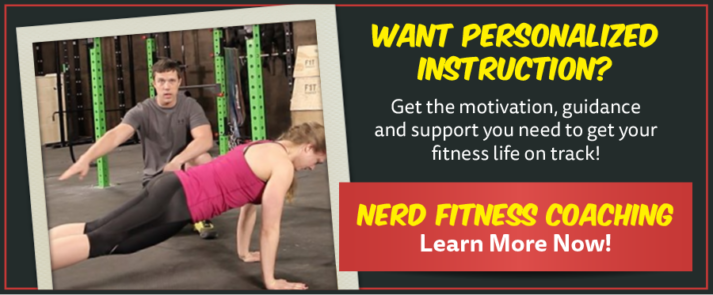This
post was originally published on
this siteOriginally posted at: http://www.nerdfitness.com/
It is true: you really can’t outrun your fork.
I kept thinking about this – over and over – when speaking with Kyle, one of our Nerd Fitness Coaching clients.
You see, Kyle works for a non-profit that promotes bicycling as a major mode of transportation.
As part of walking the walk – er, cycling the cycle – 10 years ago Kyle gave up driving a car.
Instead, he gets around by biking, walking, or public transportation.
Since Kyle bikes most days, you might think all that riding would ensure he’d stay in shape.
However, you’re reading Nerd Fitness, which means you’re smart. So you know that people can’t outrun their fork…or out pedal their fork.
Like many others who struggle to lose weight, Kyle lived off pizza and other carb-heavy foods, which brought in a ton of extra calories.
Simply put, despite the crazy amount of exercise he did every day, he still consumed more than he was able to pedal away.
As we know from study after study after study, it is very difficult to exercise your way thin. This is why adjustments to nutrition are the key to a successful transformation.
Which is exactly what Kyle did!
I’m honored that Kyle is one of our 1-on-1 coaching clients, and that we were able to offer some tips on how to go about a vegetarian diet correctly, something many Rebels struggle with.
Switching up his diet is not the only accomplishment Kyle has made: he is also now crushing pull-ups!
Which makes me really happy.
You don’t need to hear all about it from me though: let’s bring in Kyle!
HOW KYLE STOPPED TRYING TO OUTRUN HIS FORK AND LOST 27 POUNDS
 Steve: Hi Kyle! Thank you so much for taking the time to chat with me.
Steve: Hi Kyle! Thank you so much for taking the time to chat with me.
I’d love to hear from you about your past – Can you take us through a typical day before you started your journey with Nerd Fitness?
Kyle: My day would include an early morning to make breakfast and get the kids ready for school. Then I’d ride my bicycle to the office. I’d work all day – stopping to purchase and eat pizza or a sandwich for lunch. After work, I’d ride my bicycle home. Evening time would be spent hanging out with my kids until bedtime.
On days when I am traveling, substitute family time and school preparations with sitting in an airport or hotel. And I travel a lot.
Steve: Traveling can be grueling, especially when being on the road takes you from your family.
I find it interesting you bike to and from work. But from talking to you, I know it wasn’t enough to prevent you from gaining weight.
Can you tell us a little bit about your fitness journey prior to finding Nerd Fitness??
Kyle: For more than a decade, I’ve incorporated some physical activity and healthy eating into my daily routine:
I gave up driving a car as my primary mode of transportation about 10 years ago and rely on walking, biking, and public transportation to get around.
I’ve been a vegetarian for more than 15 years.
And I’ve engaged in other extracurricular activities like indoor soccer, running half marathons, or mountain biking.
I often thought that all this was enough to keep in shape without the need to adjust my diet or routine.
Steve: I hear ya – I can also see how it could be frustrating to do “all the right things” and not look the way you want to look for all that effort! You were already exercising, watching what you ate, and stayed active.
What made you decide that something needed to change?
Kyle: Last year, my wife lost 60lbs almost entirely by changing her diet.
In June, she and I had the opportunity to take a short vacation together without our kids.
We took a lot of photos during that trip and after looking at them – compared to her new, lighter, look – I realized how much weight I had personally put on over the last couple of years.
Starting a new job, moving the family across the country, and adapting to a new hectic travel schedule for work had left me 30 pounds heavier than any time previously in my life.
When we got back home, I started looking for local gyms and fitness programs that I could join, but none worked with my busy travel schedule (seriously, I travel a LOT) or weren’t convenient enough for me during the time I was home.
I didn’t want to give up the precious time with my wife and kids when I wasn’t traveling, so I began looking for alternative solutions and stumbled upon Nerd Fitness.

Steve: I’m so happy you made your way to our strange corner of the internet. We’re very lucky to have you as part of the Nerd Fitness community, and we’re glad you chose us to kickstart your journey, brother!
You’ve been working with Coach Matt M., what is he having you do?
Kyle: I asked Matt to design a workout that could be done either at my hometown gym or in any random hotel in the world with an unknown quantity of fitness equipment.
Because my environment was constantly changing, I needed a workout program that worked anywhere and everywhere.
I also stressed that my past anxieties about going to a gym centered around not knowing what to do – how many reps of what exercise, should I use the machines or not, is this too much weight or too little.
It was all just a bit dizzying.

Simply put, Matt provides a workout routine in three supersets that can be accomplished in about 60 minutes. Each exercise has one or more alternatives that can be performed depending on what equipment is available.
The supersets usually progress from core body routines, followed by heavy lifting, and concluding with lighter lifting that also engages a bit of cardio. The alternatives provided keep me on pace when I don’t have barbells or other equipment while on the road.
Since I spend about 50% of my time traveling, having nationwide access to my trainer has been a game changer.
Training while on the road works in most cases, and there have been some scenarios where the alternative training exercises Matt provided were essential to staying on track.
Being a NF client made that both easy and possible.
I’m proud to say I haven’t missed a workout since we started working together.
This has helped with the confidence that no matter where I am, I won’t fault in achieving my goals.
The consistency is paying off. For the first time in my life, I’ve been able to rock pull-ups! I’m the strongest I’ve ever been.

Steve: That’s great! Although I’m super-biased (I have a coach who programs road workouts for me too), I think NF Coaching is perfect for people who travel a lot. When you think about it, you have worldwide accountability and expertise!
What’s been the most important change you’ve made since starting this recent journey??
Kyle: Eating.
Like I mentioned before, I’ve been a vegetarian for a long time, but often resorted to carb-heavy breads, a dizzying amount of melted cheese, and chips to fill in the hunger between salads and quinoa bowls.
Matt helped me track my eating and make adjustments that still worked with my dietary preference.
Like the workouts, Matt also helped me design meal options for my busy travel schedule – protein bars and shakes – so I wouldn’t be driven to a slice from Sbarro between flights.
Being a vegetarian, I spend most of my effort maintaining consistent levels of protein intake. Since consuming protein comes along with either fat or carbs, balancing the amount each day was the biggest adjustment I made.
As we progressed beyond what foods I like to eat that work within those parameters, we began incorporating carb loading on workout days, intermittent fasting when I’m not traveling, and small dinner plate usage for portion control.
Steve: That’s amazing! I’ve written before that a common mistake vegetarians make is simply living off bread and pasta. I’m really happy that Matt was able to take an objective view of your diet and make some suggestions.
What’s a typical day for you like now? Workouts, diet strategy, and so on. Give us the details!
 Kyle: On workout days, I’m normally at the gym by 5am. It’s early – but it just works for me to get the workout in first thing in the morning before my kids are awake or I go to work. The gym isn’t normally too busy then either.
Kyle: On workout days, I’m normally at the gym by 5am. It’s early – but it just works for me to get the workout in first thing in the morning before my kids are awake or I go to work. The gym isn’t normally too busy then either.
After my workout, I skip breakfast and bike to my job. I’ll drink coffee and water all morning during work and usually have a light lunch around noon.
My recent go-to is a plate of raw veggies with hummus and hot sauce. A couple of hours after that I have a protein shake as an afternoon snack. Then I’ll bike home from work and begin cooking dinner for the family. This is usually my biggest meal of the day. Often it includes eggs.
We’ve also been experimenting with using cauliflower in all its forms. Since my wife is continuing the diet plan that helped her lose 60lbs, it’s really easy to keep on track by eating together.
Steve: It sounds like you have a solid routine: you’re very active and prioritizing nutritious meals. Great job dude!
Besides your routine, what else has changed about you?
Kyle: I’m definitely able to wear clothes I couldn’t have worn a year ago. Now that I’m smaller and weigh less, trying on clothes really makes me aware of how heavy I had gotten.
There’s also a joy in sharing this transformative moment with my wife.
We are both working on our selves side by side, and it adds a level of support that I find really helpful when all I want to do is eat an entire cheese pizza, lol.
Steve: I love that you guys are supporting each other – and I can’t wait to see where you are a year from now!
Do you have any words of advice for somebody who just starting out on a weight loss journey? What if they’re considering a change, but not sure where to start?
Kyle: Coach Matt helped me realize a person doesn’t have to make all the drastic changes overnight.
To anybody starting out, going one step at a time is easier than trying too much, too fast!

Even though I was prepared for a bigger shock, Matt’s coaching eased me into new routines and only after I demonstrated a commitment to those did he offer something new.
And honestly, that’s been really helpful when it comes to eating.
Also, if you travel, a remote coach you can access from anywhere is awesome! It turned out to be exactly what I needed.
Steve: Traveling can be tough to maintain healthy habits, so I’m glad you found a solution that works for you.
Okay, I’ve got to ask: where do you plant your nerddom flag?
Kyle: I’m all in for Star Wars (and a minor participant in most other fandoms).
The family and I attend cons on a regular basis and are trying our hand at cosplay for the first time this year!
I’ve also got a huge vintage Star Wars action figure collection that my kids and I add to regularly.

Steve: A Star Wars collection you let your kids even look at? Dad of the year… Some fathers won’t even let their kids in the same room as their collectibles.
Where do you go from here Kyle? What goals and habits are you still working on?
Kyle: We’re definitely working to lose a few more pounds, which would bring me down 30lbs! We’re tackling this mostly through the addition of interval cardio training and small diet alterations.
Additionally, we’re working to reach some interesting physical fitness goals.
I’ve never been able to do a pull-up, but now I’m doing two each workout (and working towards more).
I’m not sure what we’re working on next, but I’m looking forward to the next steps at getting there.

Steve: YES! Welcome to the “I love pull-ups and want to tell the world” club. It’s the best club.
Thank you so much for taking the time to share your story with us Kyle! Best of luck to you and the family!
THE 5 KEYS TO KYLE’S WEIGHT LOSS AND LEVEL UP SUCCESS

In speaking with Kyle, I realized he had a few key traits that helped him succeed where many others fail.
Lots of people try to get in shape.
Many of them have a lot of the same obstacles to overcome as Kyle:
- A crazy travel schedule.
- Responsibilities as a new dad.
- A diet too dependent on carb-heavy foods.
What’s special about Kyle is not the challenges he had to face. We all have unique barriers in our lives.
What’s special about Kyle is how he went about systematically overcoming those barriers.
In speaking with him, and analyzing his choices and decisions, I think there are five traits that set Kyle apart.
Here’s what we can learn from Kyle’s success:
#1 KYLE KNEW WHEN TO ASK FOR HELP
There’s nothing quite like a spouse or partner or friend who is crushing it to motivate you to make some changes.
Kyle’s wife decided to get in shape after having their two kids – she created a plan, stuck to it, and lost 60 pounds.
When checking out photos from a recent vacation, Kyle knew his wife was on the right track.
He, however, was not.
But he didn’t know what to do: he was already eating the way he thought he should, he was biking every day, and staying very active. The results just didn’t match the effort.
And he was also stuck due to his work schedule: Traveling made any kind of fixed routine impossible. What does one even eat at an airport that isn’t pizza?
Kyle knew things had to change, so he decided to ask for help from a professional. A professional that spoke his language: a dad that loved Star Wars.
That extra pair of eyes from Coach Matt – a father of 2 (and huge nerd), which allowed Kyle to see things in a whole new way.
Asking for help was a great first step, and then he did something many people forget: he actually LISTENED!
#2 KYLE LEARNED YOU CAN’T PEDAL YOUR WAY THIN
When people want to get in shape, they often think that hours of cardio is the answer.
They’ll start a running routine, or buy a treadmill, or even start biking to work.
While exercise and movement are critical for heart health and overall happiness, we here at Nerd Fitness know “You can’t outrun your fork.”
I think it’s super awesome that Kyle works to advocate cycling as a major mode of transportation. More bikes on the road and fewer cars is great for everybody involved – including the planet.
However, Kyle learned a valuable lesson: biking miles a day, in of itself, is often not enough to get in shape – unless it’s combined with changes to nutrition too.
We highlight over and over here at Nerd Fitness that 80%-90% of the weight-loss equation comes down to a proper diet. After gaining 30 pounds as a new dad, despite pedaling his bike every single day, Kyle knew something had to give.
He lost weight – though I think maybe 1 of those pounds might be from trimming his beard! Ha 🙂

#3 KYLE ADJUSTED HIS PLANT-BASED DIET
While Kyle spent a lot of calories riding his bike everywhere, it wasn’t enough to overcome all the calories he was eating in bread and pasta.
Kyle tried whenever possible to eat healthy vegetarian dishes like salads and quinoa bowls, but they never satisfied his hunger This led to him eating bread along with “a dizzying amount of cheese” to hold him over until his next meal.
So although weight loss come down to calories in and calories out, the quality of the food can really impact how easy or tough it is to stay within your calorie goal for the day.
It took an outside pair of eyes, from Coach Matt, to point this out to Kyle.
Now, Kyle prioritizes a healthy plant-based diet.
He skips breakfast and snacks on veggies and hummus and a protein shake during the day. His big main meal at night will often include eggs, a great protein source for those on a vegetarian diet.
The fiber from the plants and the protein from the eggs help keep Kyle full from meal to meal. So he can bike around town and not be tempted by the pizza joints on every corner.
#4 KYLE MADE THE ROAD WORK FOR HIM
Traveling can make getting in shape challenging.
Your normal routine is thrown out the window.
Instead of cooking your own meals in your kitchen, your dependent on restaurants. Instead of having access to your normal fitness facility, you get the rundown treadmill the hotel keeps so they can say they have a gym.
Here’s the thing though: you don’t need a gym to train. You can work out in a nearby park, find an empty playground, or even just do bodyweight exercises in your hotel room.
The important point is consistency. To not lose momentum on the days you’re away from your home.
With Matt’s help, Kyle developed a plan on workouts to do from anywhere.
If he’s at home?
Perfect, he’s off early to the gym to crush his training.
If he’s traveling?
No problem, Matt built workouts that don’t require any equipment whatsoever.
No momentum is lost.
If you live on the road, don’t let it become an excuse to not train. If half your days are spent in hotels, that’s plenty of time to continue growing stronger.
Make exercise your one constant when living out of luggage.

#5 KYLE HAS A SUPPORT NETWORK
I’m so happy that Kyle’s wife is also on her own journey, going about things her own way. They’re also supporting the heck out of each other!
This means it’s two heads in the kitchen instead of just one.
When Kyle has to wake up early to hit the gym, his wife understands (and vice versa!).
They both want to prioritize their health, for their own future and the future of their children. Having someone in the house whose on the same fitness journey is a godsend.
Plus, it’s not the only support Kyle has.
His coach, Matt, also has his back. This non-judgemental extra pair of eyes proved critical.
Matt helped Kyle see, with a little bit of adjustment, his vegetarian diet could be a tool for weight loss. Matt helped Kyle create a plan for the gym, so he could get in, know exactly what to do, and get out.
Matt adjusts Kyle’s workout on the fly depending on his travel schedule for the upcoming month. Every day, Kyle wakes up, looks at the NF App, and knows exactly what he needs to do.
The lesson: if you can, find a fellow Jedi or a Jedi Master!
Maybe your spouse has expressed interest in getting in shape.
Maybe you have a brother or sister or roomate who wants to start strength training, and you two can share your progress with each other.
Maybe you have a coworker who also wants to go for walks at lunch with you.
Or perhaps you can hire expert guidance, like a coach, to help make plans and recommendations for you to hit your goals.
A companion can be a lifesaver for when things get difficult, so team up – even if it’s just for accountability!
WHAT SMALL CHANGES CAN YOU MAKE, LIKE KYLE, TO LEVEL UP YOUR LIFE?

The great thing about Kyle’s transformation, is he is still Kyle!
Kyle still takes his bike to work every day.
Kyle still follows a vegetarian diet.
And Kyle still shares his love of Star Wars with his kids, because kids should know about Star Wars.

Sometimes, you don’t need to do a complete life overhaul to level up your life.
Sometimes, an outside pair of eyes can point out some key changes you could make, to help you reach your goals.
No matter where you are on your fitness journey, I would encourage you to think about what made Kyle successful:
- It’s okay to ask for help. You don’t know what you don’t know. Asking an expert to take an objective review of your life can be immensely valuable.
- You can’t peddle your way thin. I wish getting in shape was as simple as biking to work. While it is a great lifestyle habit, diet will still be 80-90% of your success.
- Be careful with a vegetarian diet. Vegetarian or not, you still need to know what you’re eating! A salad and quinoa bowl can be vegetarian, but so can pizza and donuts. You can absolutely do a vegetarian or vegan diet incorrectly. So, don’t do that!
- Don’t lose momentum on the road. Staying fit while traveling can be tough. However, if you make a plan, it’s an obstacle that can be overcome.
- Don’t make this journey alone. If your spouse wants to get in shape with you, great! Take them up on it! If this isn’t an option, a coach can also be a great accountability partner.
If you related to Kyle’s story, seemingly doing the right things without making any progress, think about what you can do differently.
Start by testing your assumptions:
Maybe running on a treadmill for an hour isn’t enough to burn the calories from all that pizza at lunch.
Maybe a vegetarian diet should include vegetables.
Maybe pull-ups are the best. I know Christina, another coaching success story, agrees!
As we learned from Kyle, an outside pair of eyes can be really useful for analyzing your routine. Sometimes it’s hard to look at ourselves objectionably.
Depending on your current situation, our 1-on-1 NF Coaching Program might be just the extra pair of eyes you need! Someone who can learn your life, understand your individual obstacles, and make a plan for success!
Want to learn more? Go ahead and click on the box below and schedule a call with our team!

No matter what you do, here’s what I want you to take away from Kyle’s story:
- Diet is everything. You can still gain weight even if you bike to and from work. If you aren’t making the progress you’re after, look into a different nutrition strategy.
- Make small changes, but make changes. Are you frustrated that what your doing isn’t working? Try something else this time!
In a year and a half, by focusing on the above two points, Kyle got within 3 pounds of his goal weight (27 pounds down at the time of this writing).
If you started focusing on your diet with small sustainable changes, I promise you in 18 months, you’ll be closer to your goal than you are today.
The important thing?
Start!
Not tomorrow. Not next week.
Today!
-Steve
PS: I want to give a special shout out to Coach Matt, who provided the non-judgemental pair of eyes Kyle needed to level up his life.
If you are somebody that wants to have your own Yoda guiding you in the ways of the Force, check out or 1-on-1 coaching program, and I could be sharing YOUR story this time next year!
PPS: Speaking of success stories…If you’ve had success with any aspect of Nerd Fitness, whether it’s our free workouts, Academy, or Coaching, email us! Send your story to contact(at)NerdFitness(dot)com and let us know so we can share your adventure with the galaxy!


 With the explosion of keto, there’s an ever growing constant stream of new information about the significant benefits, supposed risks, and varying “rules” for how to adopt a keto diet. As with most things, it’s easy to get sucked into information overload. (And that doesn’t even take into account the hype that unfortunately gets distributed like wildfire around the Internet.) You want sources you can count on for facts, reason, and utility. Here are eleven solid sources I’d recommend for intelligent commentary, sound science, and useful ideas.
With the explosion of keto, there’s an ever growing constant stream of new information about the significant benefits, supposed risks, and varying “rules” for how to adopt a keto diet. As with most things, it’s easy to get sucked into information overload. (And that doesn’t even take into account the hype that unfortunately gets distributed like wildfire around the Internet.) You want sources you can count on for facts, reason, and utility. Here are eleven solid sources I’d recommend for intelligent commentary, sound science, and useful ideas.


 One of the most common questions I get is “Does [x] break a fast?”
One of the most common questions I get is “Does [x] break a fast?”

 For today’s edition of Dear Mark, I’m answering three questions. First up, what can a person do to help their gut recover its barrier function after too many antibiotics? Are there any foods, supplements, or dietary strategies? Second, what can explain rapid fatigue during sprint sessions on a keto diet? Is this simply part of the deal, or are there modifications you can make? And finally, what do I do when I know I’m going to get a bad night’s sleep?
For today’s edition of Dear Mark, I’m answering three questions. First up, what can a person do to help their gut recover its barrier function after too many antibiotics? Are there any foods, supplements, or dietary strategies? Second, what can explain rapid fatigue during sprint sessions on a keto diet? Is this simply part of the deal, or are there modifications you can make? And finally, what do I do when I know I’m going to get a bad night’s sleep? Steve: Hi Kyle! Thank you so much for taking the time to chat with me.
Steve: Hi Kyle! Thank you so much for taking the time to chat with me. 


 Kyle:
Kyle: 








 For now classes are 6pm and 640pm at 2840 Wildwood st in the Boise Cloggers studio.
Book your class NOW!
click this ==>
For now classes are 6pm and 640pm at 2840 Wildwood st in the Boise Cloggers studio.
Book your class NOW!
click this ==>








